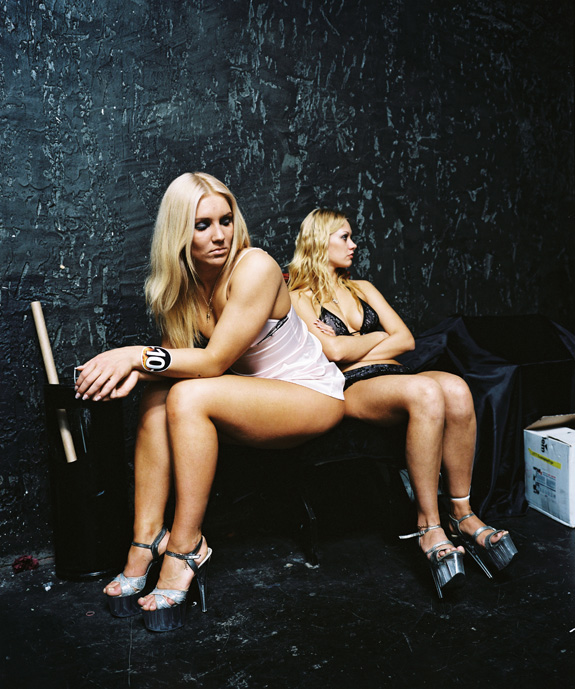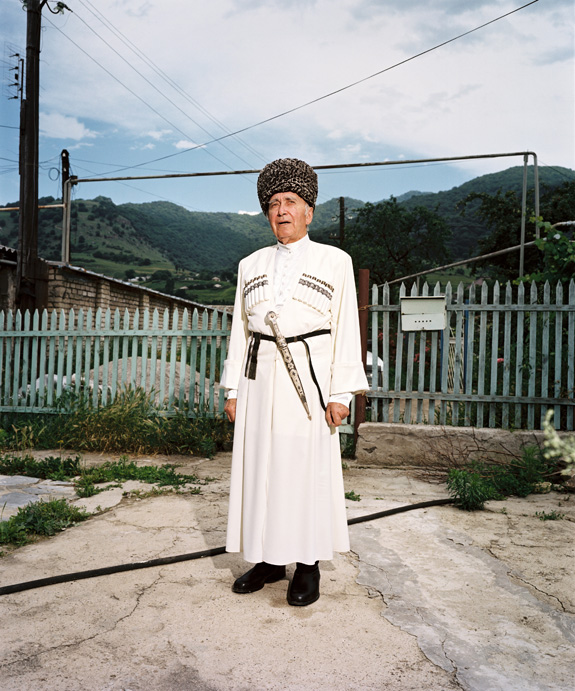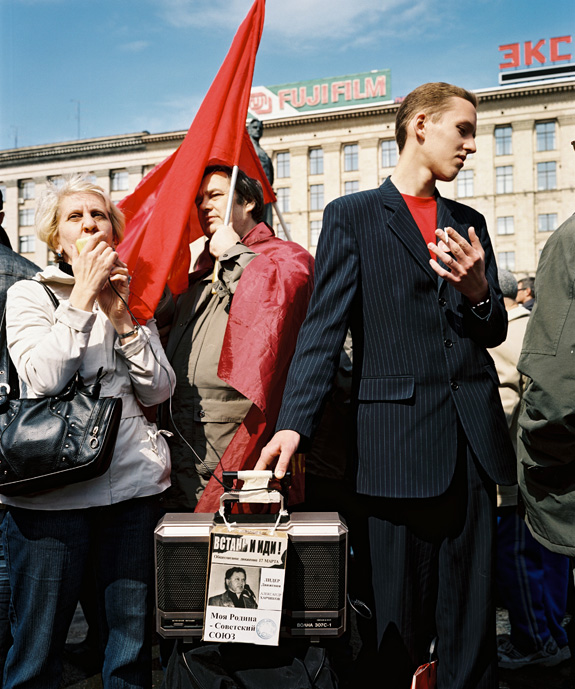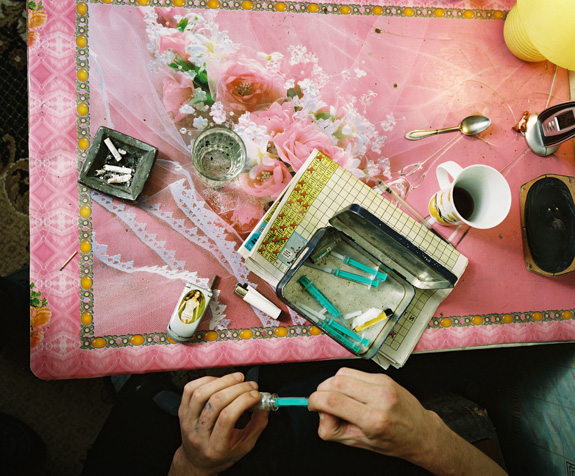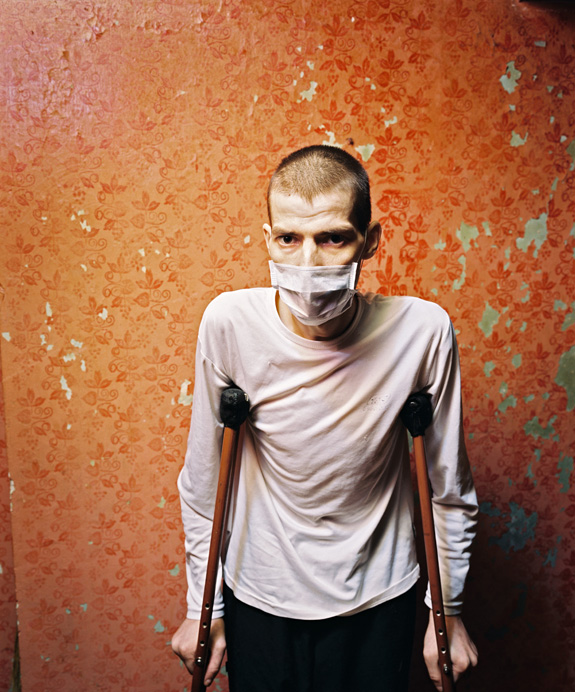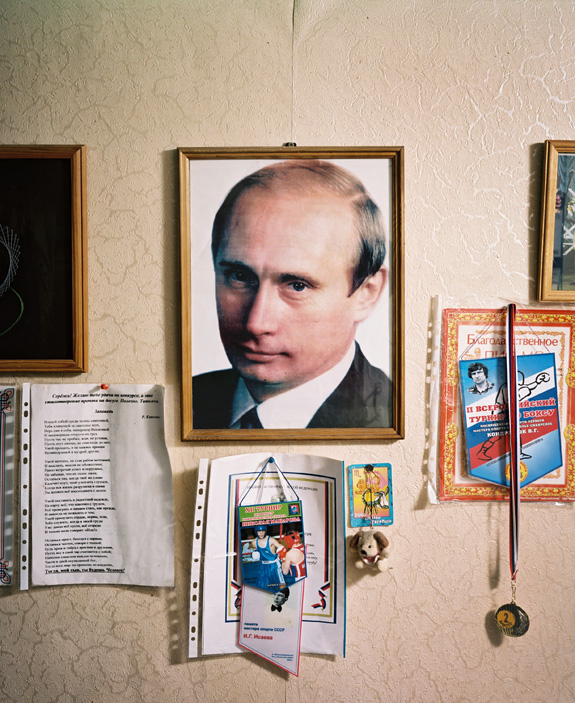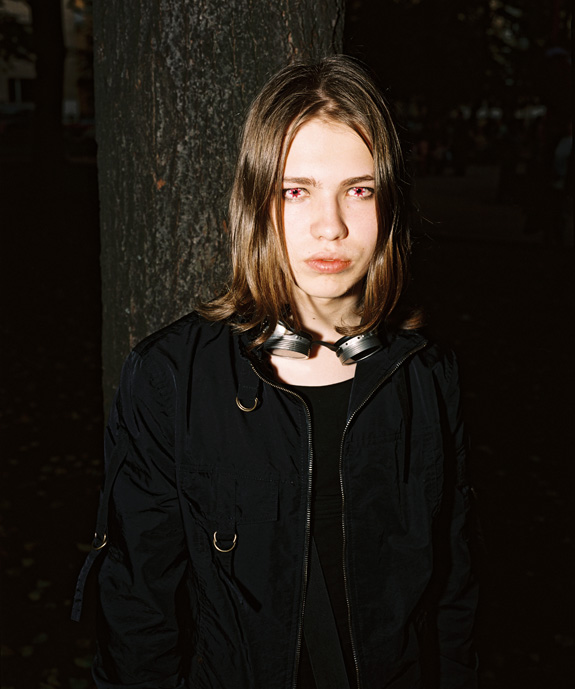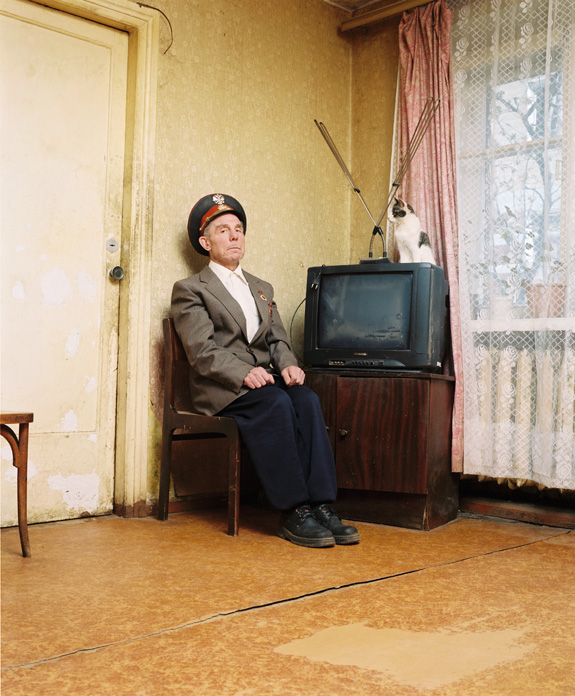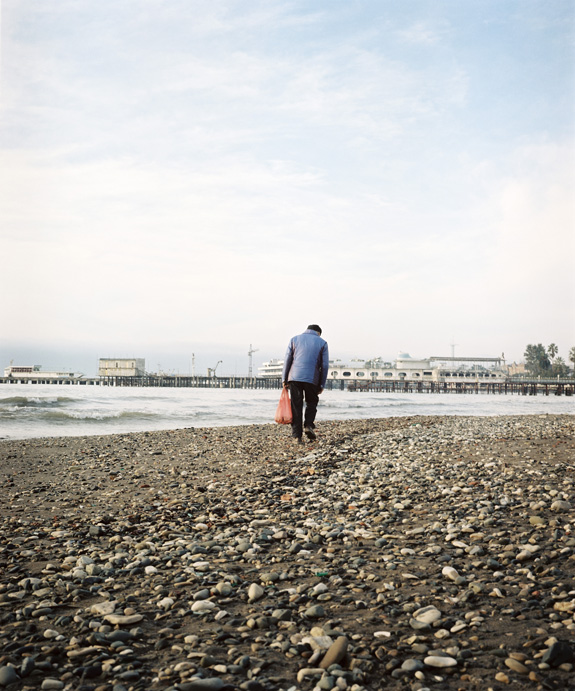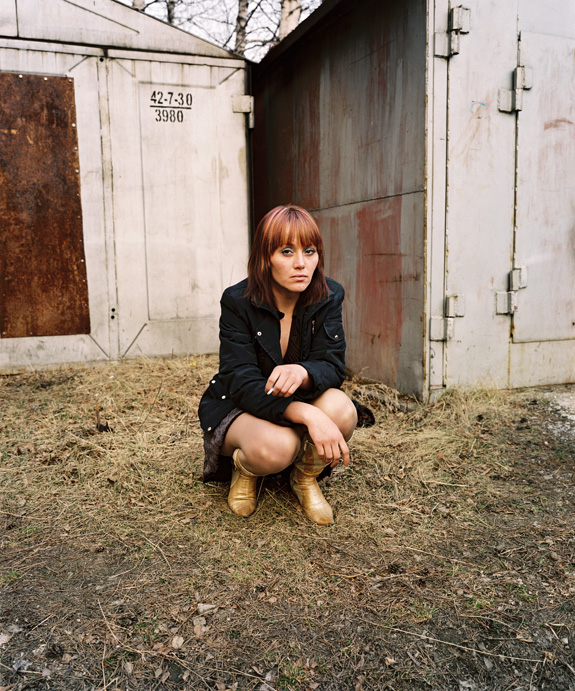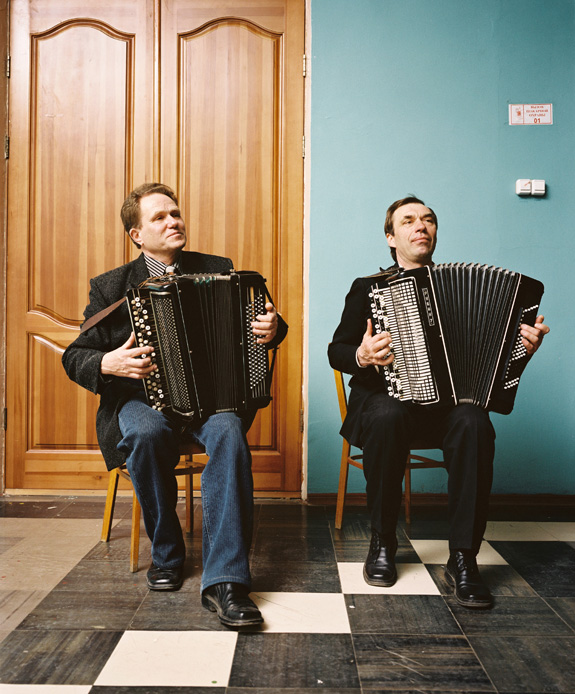At the beginning of 2008, the list of the richest Russians contained 101 billionaires; a magical number that for the time being will not be matched. These photographs document a very different Russia.
Fifteen women are battling it out for the title “Best Female Striptease from the Urals.” They come from Magnitogorsk, Tyumen, Nizhni Tagil, and the regional capital Yekaterinburg. The final is composed of three parts: an interview, a lap dance, and a freestyle strip act. The interviews with all the dancers are a disaster. The microphone is broken and none of the girls has a good voice. Anyway: it is impossible to understand a word. But this is perhaps the fault of the audience who can’t keep quiet. The lap dance is hilarious. The bottles of vodka being served can’t keep up with demand. And then the closing number. The girls have to improvise to completely unknown music. Nastya from Tyumen, who stood out in the qualifying round with her own, slowly sensual style, has difficulties with Rammstein. She’s hopeless. Valeria does a little better; although her spectacular closing spin on the pole doesn’t end well. Natalie steals the show. She dances to a steamy French number, throws her underwear into the audience, crawls over the jury table, and toys shamelessly with the male commission members. She wins the first prize: a holiday to Turkey. The second and third prizes respectively are an LCD TV and a sound system from an unknown Chinese brand.
Azamat Suyunchev (ninety-two) lives in Karachayevsk, a small town in the Caucasian republic Karachay-Cherkessia. We have just had a tour lasting several hours of his house, which also serves as an office and library. Suyunchev is an impressive figure, but straight to the point he is not. Neither is his business card. Suyunchev is the national poet of the Republic of Karachay-Cherkessia, laureate of the Kabot prize for literature, member of the Writers Unions of the Soviet Union and Russia, and a professor of literary sciences. Suyunchev’s house is packed to the rafters with books. Pick any subject and he will have a book on it. But above all, he has history books. On this side of the world you are subjected to continual history lessons. Every Caucasian forces the age-old justification for their existence on you. Or claims to be linked directly to one of the forefathers from the Old Testament. In the first years after the fall of the Soviet Union in particular, this led to notable historical “discoveries.” Around 1993, the discovery of Adam and Eve’s Garden of Eden was announced simultaneously in Abkhazia, Chechnya, and Armenia.
Until the rise of Putin, the Communists were a feared political power. In 1993, they could only be stopped with military force. In 1996, the then President Yeltsin had to employ all the financial and political influence of the billionaires in order to be re-elected. The current Communist Party is a Stalin-glorifying, nationalistic party, not at all comparable with the CPSU of the final days of the Soviet Union. Its electorate longs primarily for the good old days, a time when life at least was clear. When Abkhazia was still the holiday paradise to which you could be sent on vacation as a reward for your productivity or services to the party. When the raw capitalism that threw so many lives in the former Soviet Union into disarray didn’t yet exist, and the illusion was maintained throughout the country that the state would take care of everything. These demonstrators still believe in this whole-heartedly. But behind the scenes, the Communists play an active part in Russia’s political game, referred to as virtual politics, the cynical game played by Kremlin spin doctors who can single-handedly make or break opposition parties, just as long as the Duma remains completely loyal to the president.
Russia is Europe’s largest heroin market. According to human rights organizations such as Human Rights Watch, the country has more than one million users, nearly 0.75 percent of the population. In total, between three and six million people in Russia use hard drugs.
In the nineties, intravenous drug use increased exponentially. For a long time, the HIV problem in Russia was ignored. No information was distributed about the risks of shared needle use. Clean needles were barely available. Needle-exchange programs are still taboo. Only in a few cities and on a small scale are clean syringes distributed. Between 1995 and 2001, the number of HIV infections in Russia at least doubled every year. In any event, ten percent of all drug users are HIV positive. And that’s only a wild guess. In Russia, very few statistics are reliable.
Andrei sits on the edge of a narrow bed. Sitting causes him obvious pain. He is from the first generation of young people who, in the middle of the nineteen nineties, started using drugs en masse. His sister is also an addict and she also has AIDS. The boy who just opened the door is her son, Andrei’s nephew. The house is a gathering place for drug addicts. In exchange for a few daily fixes, Andrei’s buddies are allowed to use the flat. Andrei is suffering from an open form of resistant TB. Just to be safe, we put on surgical masks. Lena doesn’t, as a form of respect. She’s known Andrei since she was a child. She asks him how he is and then leaves us alone. She has to go back to the street. Six weeks after our visit we call Lena to find out how Andrei is. We are just too late; Andrei died two days earlier. Andrei deteriorated rapidly. They let him lie for increasingly long periods, always on his least painful hip, with his face to the wall, as he slipped away in a feverish sleep. He continued using right up to the very end, even though injecting became harder and harder. They just put the needle in his wasted upper arm. This whole time no doctor had paid a visit. One day, Andrei’s hand hung limply over the edge of the bed. Through Lena they called a nurse. She told them: “Just call an ambulance,” and they had carried him out of the flat and driven him to the tuberculosis clinic. The next morning Andrei was dead.
Children’s home number one is clean and tidy. In Russia it is relatively easy to take your baby to a children’s home, but it does require you to relinquish all your rights. In many cases, it is drug or alcohol addicts who bring in their babies. This infuriates the director. She calls some mothers conveyor belt mothers. “They should sterilize them. What kind of mothers are they? They keep drinking and taking drugs, even when they’re pregnant,” she says. These children exhibit serious deficiencies. “This little baby came in three days ago and is already my favorite. She is a very happy baby, very bright.” She will stay here for four years before she has to move to a home for older children. The director tries not to think about it.
Employee preparing fish in the cement factory’s canteen. It is as if the moment the cement factory was completed in the fifties, the ice age set in. “Our factory was the most beautiful in the Soviet Union’s industrial culture. We produced above capacity. It was a clean factory; there were six greenhouses where we grew roses, which we distributed on Women’s Day. That’s no longer possible; we are only allowed to make cement now. The factory was awarded the Order of Lenin twice. Then the Perestroika destroyed everything. We have lost eighteen years. The collective has fallen apart.”
One of the most important changes that Putin has pushed through as president is the centralization of state power. Since 2005, all governors are appointed by the president. Prior to that, they were chosen democratically. As a result, there is little room for regional policy. Regional politics is weak and has little control over how government income is spent, the majority of which, incidentally, goes to Moscow. Moscow is like an empire within an empire, distant and unassailable. When Transneft, one of the larger oil companies in Russia, wanted to lay a pipeline along Lake Baikal countless organizations and local government bodies protested. Even the governor of Irkutsk spoke out about the project. But nothing could put the mighty company off its course. Until Putin himself got involved and forced Transneft to move the pipeline several kilometers to the north.
Sasha is a cyber Goth. His nickname is Suicide Online. He is a singer in a band. “Our band was super popular, but we stopped performing. We had to. We were threatened from all sides. The city council initiated a campaign against our scene because our music was allegedly Satanic. It’s all nonsense, of course, they are just scared of us. Those in power want to control everything. But I’m definitely not going to wave their flag.” Neo-Nazis, punks, national Bolsheviks, antifascists, the new Russia has an eclectic youth culture. In the large cities such as Moscow and St. Petersburg, the skinheads in particular make themselves heard. In recent years, the cities, but also some provincial areas, have been shocked by racist attacks. Not only non-whites but also the inhabitants of, for example, Caucasian republics have been the victims of attacks by skinheads. The People’s Friendship University was originally set up to advance friendship and cultural exchange between Africa and the Soviet Union. Even though many African students still study there, the area has become almost a “no-go” area for black students. In 2007, thirty-seven victims of attacks by skinheads died across Russia. In 2008, a large group of perpetrators was sentenced. Self-made films that had been distributed over the internet provided damning evidence. In general, the cause of the significant number of skinheads (according to one expert, 50 percent of all the neo-Nazis in the world live in Russia) is traced back to Russia’s “lost” nineties. The deep humiliation that, according to many, Russia suffered in those years, in combination with the considerable poverty and social inequality, gave birth to a group that seeks its salvation in hate and violence.
When Alexander Zelekson (sixty-two) hears that a photographer wants to photograph him, he races back to his apartment to put on his official suit. We are shown around by Anna, a girl in her twenties from Nizhny Novgorod. We walk along the banks of the Oka River. Anna loves her city. “This is the future of Russia,” she says. “Investors from Moscow have decided to turn this into a second Moscow.” The area comprises a few Soviet flats and a whole lot of wooden houses that have stood here for decades. These will have to make way for the ambitious investors’ new building projects. The residents are being bought out for a song. If they refuse to cooperate, they could find that their wooden house suddenly and spontaneously bursts into flames. It remains to be seen whether Alexander Zelekson is already aware of this. For more than forty years he worked in Nizhny Novgorod, both at the metal factory and for the police. He is now retired. He arrives in a hurry, with police cap and all, to pick us up again. We go to his small apartment in the Soviet block of flats. Now and then, he still pulls over a car that is driving recklessly. “They can’t do without me,” says Zelekson. Anna starts to get impatient. She doesn’t feel like translating for us. She prefers to give people a wide berth and when we finally start talking to someone like Zelekson, she mostly translates the stories with: “Oh yes, they’re always the same stories. Old bores.”
Paradise lost is how many Georgians and Russians refer to this small coastal area on the Black Sea. It is just one hour’s drive from the capital Sukhumi to the Russian border. An hour to the south and you are in Georgia. That’s how small Abkhazia is. But with its deep-sea harbor, stone quarries, and a strategic location along the Caucasus, this area is worth fighting for. In a short but bloody war in 1992 and 1993, the Georgians lost their favorite subtropical province and the Russians their most exclusive holiday paradise. Abkhazia has been a pariah since the war. But for the victorious Abkhazians, fifteen years on their paradise is little more than hell.
Natasha and Kamila solicit in a remote spot between the transport containers in the woods just outside the city. At the beginning of the road that leads here, their pimps stand on the lookout. Natasha and Kamila both earn around six thousand rubles a day, about one hundred and fifty euro. Two thousand rubles goes directly to the pimp, the rest is spent largely on drugs. After we have talked to Natasha and Kamila for a while we decide to take an alternative route to the exit. You just never know with pimps. Near Natasha’s soliciting spot is a field full of small artificial hills. It is the home to a few tramps of the really impoverished kind. “How terrible,” we say to Natasha, “to have such perverts in front of your door.” “They are so pathetic,” says Natasha pityingly. Now and then she gives them cigarettes or some money.
Any self-respecting village has a Dom Kultury, a cultural center. Cultural centers exist in all shapes and sizes. Sometimes they are small palaces of Stalinist neoclassical grandeur, complete with colonnades and jubilant mosaics; and sometimes they are just anonymous constructions, built from simple concrete slabs. Cultural centers were intended for the spiritual enrichment of the Soviet citizen. The most basic variant comprises one room that can serve as a stage for political agitation, poetry recitals, or theater performances. Since the fall of the Soviet Union, the cultural houses have suffered from neglect; the plaster is crumbling, the window frames have collapsed and so many pieces of the mosaic have fallen off that only the oldest villagers still recognize the picture of the local laborer. But apart from that, little has changed. The interiors are still exactly as they were and the same woman with big hair still sits in the cloakroom.
All Images © Rob Hornstra/INSTITUTE
Rob Hornstra (b. 1975) is a documentary photographer based in the Netherlands. Since he graduated from the Academy of Arts in Utrecht, he has worked predominantly on long-term projects, both at home and on the other side of the world. His work is characterized by a stylized rawness, with a large dose of intrinsic engagement. He has self-published three books (101 Billionaires, Roots of the Rúntur, and Communism & Cowgirls) which, despite increasing print runs, sell out ever faster. He has been commissioned by international magazines to produce documentary series and has also taken part in numerous solo exhibitions in the Netherlands and abroad. He is represented by INSTITUTE for Artists Management.
Text by Arnold van Bruggen and Hans Loos.
Further Reading:
“Less Than One” by Alexander Gronsky.
“Chronicles of a Soviet Capitalist (Parts 1 and 2)” by Irakli Iosebashvili.
“Ruski Business” by Caleb Daniloff.

